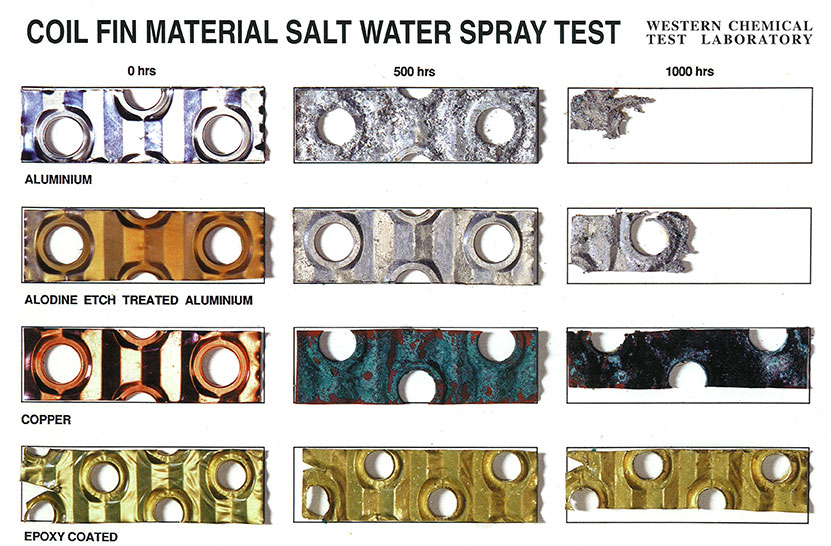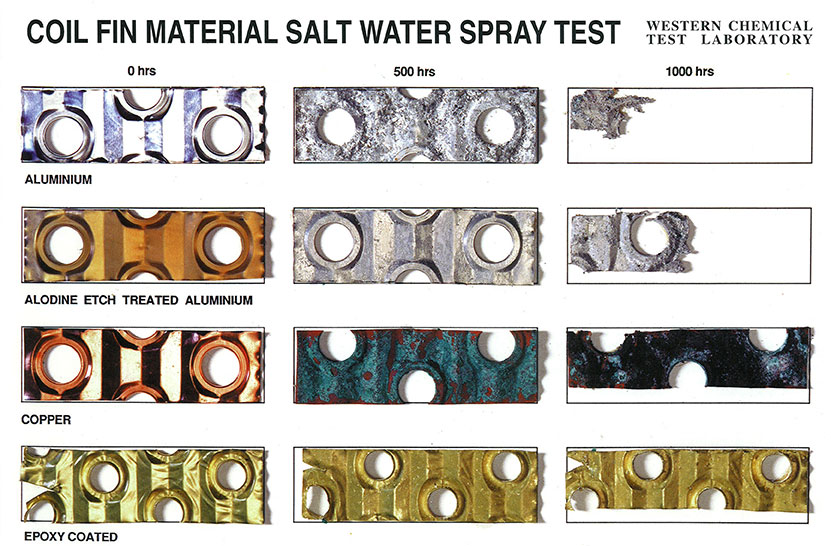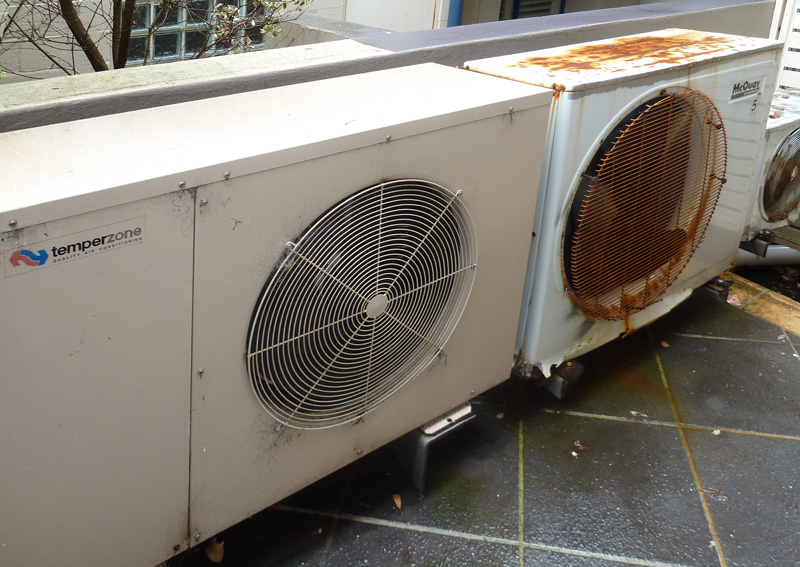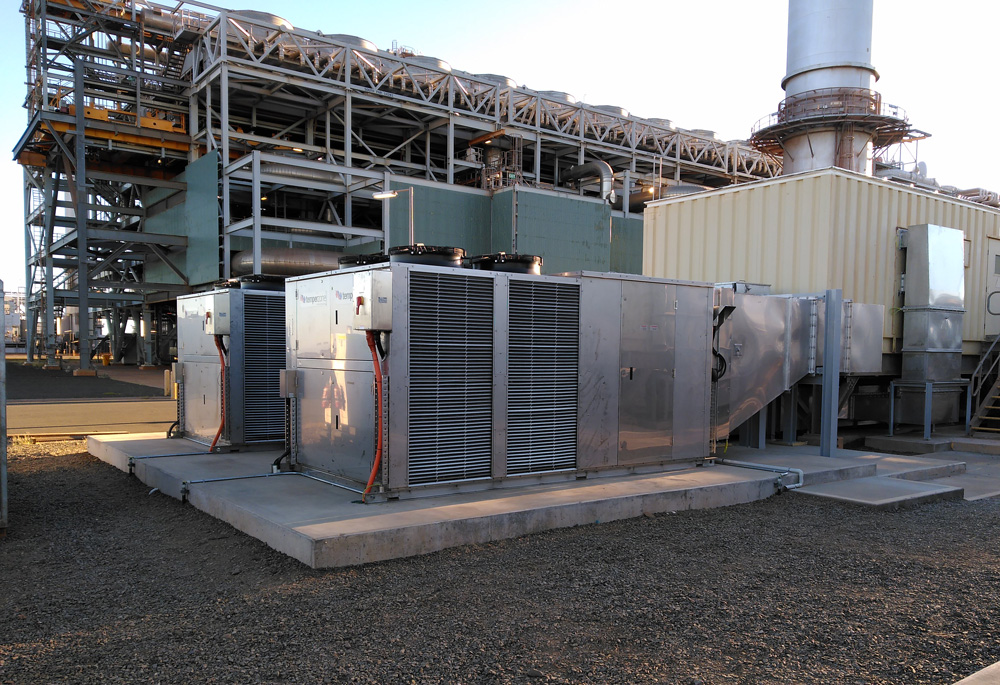Corrosion Will Reduce Energy Efficiency
The biggest short to medium term impact of corrosion on air conditioning equipment is loss of energy efficiency and hence increased running costs. The longer-term impact of corrosion can include significant reductions in energy efficiency and in extreme cases, total failure of individual components or the entire system.
Damaged or corroded fins can lead to premature failure of other components, such as fan motors. Damaged fins can impose extra static pressure on fan motors and blades leading to overheating and possible failure. Corrosion can lead to reduced heat transfer and an elevated suction and condensing temperature, which can potentially result in compressor overheating and eventual failure.
Although a damaged or corroded condenser coil will lead to an eventual costly component failure, it is the cost along the way that is the real “hidden” cost. This can be as much as a 30% increase in running amps, 35% increase in power consumed and as much as 25-30% loss in cooling and or heating ability.


Identifying Corrosion
We need to know how to identify corrosion, how to protect against and how to treat it when it occurs. You need to understand what corrosion is and how will affect the life span of the air conditioning system. Today, we need to look at corrosion not just from a construction degradation point of view, but even more importantly, how will it affect the efficiency and power consumption.
Corrosion is the gradual destruction of materials (usually metals) by chemical reaction with their environment.
In the most common use of the word, this means the oxidation of metals in the presence of moisture, oxygen and some sort of corrosive agent like salt. Corrosion reduces the useful properties of materials and structures including strength, appearance, permeability to liquids and gases, and importantly for air conditioning, their ability to transfer heat.
Many structural alloys corrode merely from exposure to moisture in the air. The process can be strongly affected by exposure to corrosive agents like salt, which accelerate the process. Corrosion can be concentrated locally to form a pit or crack, or it can extend across a wide area uniformly corroding the surface. Corrosion occurs on all exposed surfaces. As a result, a wide range of processes are used reduce the impact of water, oxygen and corrosive agents. These include the use of corrosion resistant materials. An application of treatments which reduce the corrosion activity of the surface like passivation, chromate conversion and coatings like epoxy resin.
When we talk about air conditioning system corrosion we immediately think of coil corrosion and the most talked about type of coil is Galvanic Corrosion.
Galvanic corrosion occurs when two different metals have physical or electrical contact with each other and are immersed in a common electrolyte. This combination of metals and electrolyte is called a Galvanic cell and the two metals are called a Galvanic Couple. In a galvanic couple, the more active metal (the anode) corrodes at an accelerated rate and the less reactive (more noble) metal (the cathode) corrodes at a retarded rate.
So, in a typical air conditioning coil, the aluminium fin is the anode, and the copper tube is the cathode. So, if a Galvanic Cell forms at the fin collar, where the aluminium and copper are in direct contact and water and an electrolyte like salt is present, the aluminium will be eaten away, and the copper will be protected. It is worth noting that many substances other than salt will form an electrolyte and cause accelerated corrosion. An abundance of fertilizers, industrial plant processes, pollution, or acid rain can corrode outdoor condensing coils.
The following are sources of coil corrosion that could be overlooked:
-
Fermenting yeast or lactic acid from milk in bakeries or similar food processing plants.
-
Chlorine from an indoor swimming pool or aquatic process.
-
Urea (ammonia) from dead animals in meat processing plant coolers. Purged ammonia from a refrigeration plant.
-
Sulphur from well water used in cleaning coils or rooms with coils.
-
Bore water used in remote sites and mines can be highly mineralised.
-
Fertiliser (ammonia) in agricultural building evaporative coolers.
There are a number of ways you can inhibit the galvanic corrosion of an air conditioning coil at the “fin collar”.
1. Material Selection:
Use aluminium alloys that resist corrosion. Essentially the best material for heat transfer coils is soft temper material that is very pure. A range of materials like marine grade aluminium, copper or stainless steel either cannot be easily manufactured or are prohibitively expensive or both. Impurities such as silicon, nickel, iron and copper may reduce the corrosion resistance. Temperzone specifies and uses aluminium series 1100 for natural fin coils which has a 99% purity.
2. Coil Fabrication:
The quality of the fabrication process of the coil will affect the corrosion resistance. A coil which undergoes excessive stress to produce the fin shape may result in cracking at the collars and will corrode more due to stress induced corrosion. In addition, cracked collars allow a perfect site for corrosion to form. One of the theories of coil construction is that to construct a well-made coil, the collars should be tight on the copper tubes and tightly packed. This essentially forms a barrier to moisture and as such no galvanic cell can form, as no electrolyte can get between the copper and the aluminium.
3. Coil Fin Coating:
Temperzone uses epoxy coating on all condenser coil fins. We believe that this is the most successful method of corrosion treatment for coil fins.
.jpg)
Corrosion in General
There are many potential causes of coil leaks in indoor coils, ranging from manufacturing or process-related defects to copper corrosion.
Additionally, there are several different corrosion mechanisms that can affect copper tubing. The following discussion focuses on pitting corrosion failures of indoor coils.
The two main forms of pitting corrosion found in indoor coils are:
General pitting corrosion: caused by aggressive attack on the copper tube by airborne chemicals particularly chlorides. General pitting is visible to the eye and may ultimately lead to total refrigerant loss.
Formicary corrosion: (sometimes called ants nest corrosion), on the other hand, appears as multiple tiny pinhole leaks at the surface of the copper tube that are not visible to the human eye. Upon microscopic examination, the formicary corrosion pits show networks of interconnecting tunnels through the copper wall, hence the association with ants’ nests. The agents of attack involved in this corrosion mechanism are organic acids like acetic acid found in vinegar.
Formicary corrosion is very hard to detect with the first obvious sign usually being refrigerant loss. This type of corrosion can be very quick acting with total refrigerant loss in 3-4 months.
Case Corrosion: Corrosion of the outdoor unit case is very common and can ultimately lead to total failure of the unit. Make sure the case is made from materials that are appropriate to the onsite conditions. Temperzone’s standard case is manufactured from galvanised sheet steel which is then powder coated. We also offer Made to Order cases from a range of materials up to 316 stainless steel.
The most important things to remember about corrosion are:
-
The biggest single cost of any corrosion is probably seen in the electricity bill.
-
Don’t delay in taking remedial action as soon as the corrosion is noticed.
Preventing corrosion before it starts is by far the cheapest option, through correct product selection and careful maintenance.
The Temperzone Approach to Corrosion Prevention
Corrosion has some impact on virtually all air conditioning systems over their life cycle. Good manufacturing practices, like those used by Temperzone, means that for most applications corrosion is no longer a critical issue.
However, there are lots of extreme environments that call for more than the basic corrosion resistance. Building the right corrosion resistance into a system as it is being manufactured can save thousands of dollars. Particularly when you add up the costs of repair and maintenance, reduced efficiency which equals increased running costs and ultimately early replacement of the whole system.
Temperzone’s approach to corrosion is based on the following factors:
-
Understand how different types of corrosion impact on air conditioning equipment.
-
Assess the environment in which the equipment is going to be used.
-
Evaluate the best approach to manufacturing for the given environment.
-
Build the corrosion resistance in during manufacture to give the units the best possible long-term efficiency and life cycle with minimised maintenance costs.
As standard Temperzone equipment comes with quality corrosion resistance.
-
Cabinets are made from PGI steel with heavy duty powder coating and all surfaces inside and outside, including edges, are completely coated. Temperzone manufactures all of their sheet steel work and has its own high quality powder coating production lines.
-
Stainless steel fixings or SKT corrosion resistant coated fixings.
-
Temperzone manufactures its own coils and all coil fins are epoxy coated.
-
Many units are designed with louvre guards for coil protection from UV light and vandalism.
Everything is managed under Temperzone's strict quality Assurance and Quality Control systems. Every standard Temperzone unit has corrosion resistance that is adequate for most applications built in.
For more extreme corrosion environments, Temperzone has a range of options which can be built into the equipment on a "Made to Order" basis. This allows Temperzone to manufacture equipment for extremely corrosive environments such as;
-
High humidity, high salt environments
-
Extreme salt environments like salt mines in NW Australia
-
High sulphur atmosphere environments which occur in some industrial applications but are common around Rotorua in New Zealand due to the geothermal activity.
Temperzone's "Rotorua" corrosion treatment process is an excellent example of how Temperzone has developed a custom manufacturing process to deal with specific types of corrosion.
Rotorua sits on top of a large geothermal field. The gasses released by the geothermal field contain high levels of sulphur and sulphur compounds. The resulting acidic atmosphere attacks the whole air conditioning system in different ways. Temperzone developed a unique approach to this environment which is included in the manufacturing process and then continued with a considered maintenance process.
-
Cabinets are made from PGI steel with heavy duty powder coating. All surfaces inside and outside, including edges, are completely coated.
-
The sulphur atmosphere attacks the brazed joints, so Temperzone uses a high silver brazing alloy, which resists corrosion.
-
Coil fins are epoxy coated.
-
After all brazing (coil and pipe joints) completed, all brazed joints and entire pipe work is then coated with “Fosroc Silaflex C (otherwise known as Sikasil C)”, a flexible white sealer that protects against rust and corrosion, at assembly line.
-
Any internal components including bought in items which are not powder coated are coated with the same Fosroc Silaflex C sealer.
-
Specific instructions are supplied to the contractor / installer to ensure any holes drilled in the sheet metal during installation are recoated.
-
While Fosroc Silaflex C is a long-term protection that needs little ongoing maintenance, Temperzone recommends an annual or bi-annual check for deterioration of this coating and any signs of corrosion.
In extreme salt application environments such as mine sites or sites close to the ocean, the entire cabinet and fixings can be custom manufactured from 316 "marine grade" stainless steel.

Before you say I don’t work in high salt environments and I don’t live in Rotorua, consider there are a number of manufacturing processes that can create a corrosive micro climate and need to be taken into consideration. In ANZ there are reports of corrosion due to diesel fumes from close proximity to motorways, aviation fuel in airport flight paths and chemicals sprayed on weeds or grasses.
So, if you are looking at a project that you think may have a corrosion problem, follow the Temperzone approach:
-
Understand how corrosion impacts on air conditioning.
-
Assess the application environment for corrosion issues before you quote. (NB Your Temperzone Branch can help with the assessment)
-
Decide on the best corrosion resistance strategy.
-
Build appropriate levels of corrosion resistance into the equipment during manufacture.
-
Talk to us, we have a range of corrosion solutions to suit your project or application.
-
And of course, don't forget to monitor and manage corrosion issues during regular maintenance.